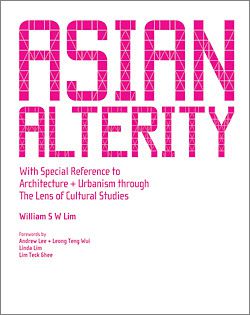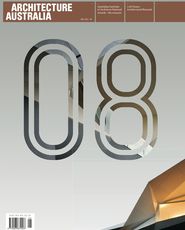ASIAN ALTERITY: WITH SPECIAL REFERENCE TO ARCHITECTURE + URBANISM THROUGH THE LENS OF CULTURAL STUDIES

William Lim. With essays, a symposium and case studies.
World Scientific, 2008. 320 pp. US$125 hardbound; $78 paperback
The title carries the implication of alternative action, besides its more literal reference to Asian cities as an other. This book is a rich compendium of observations and critique, prepared in the expectation that by 2030 sixty percent of the world’s population will be living in cities that, to contemporary eyes, appear chaotic. Asian Alterity comprises a broad thesis by Lim and comments from several “internal” reviewers, including Chua Beng-Huat, Kenneth Frampton, Michael Sorkin and Iain Borden. Lim draws from cultural studies but keeps his phrasing away from the often literal translations of French and German that we have grown used to. Among English-language commentators even Stuart Hall’s often crabbed style reads well in the quote Lim chooses.
This “distance” in tone has much to do with Lim’s concern about Eurocentricity, both in the architectural modernism he sees Asia as inheriting all round him, and (one senses) the continuing assumption pervading the cultural studies that he proposes. Lim is well aware that for much of cultural studies the interesting world still lies between Birmingham, Paris, Frankfurt and Berlin. In contrast, Lim’s interest in cultural studies is in its multidisciplinary concerns and its engagement with both high and popular culture. And a sustained study of complex urban form is, by nature, interdisciplinary anyway. Funny, though, how 1970s architectural politics (Frampton’s among them) kept so many from reaching this area till more recent European reinventions of the wheel. And at one point Lim reiterates the postmodern-equals-stylism “dead end” argument, even though the empiricist and inclusive tendency of the 1950s and 1960s was bound to be more complex in its ramifications than that generally European reduction would suggest. The Modernism Lim tackles is the high 1920s variety and its corporate aftermath rather than the arguably broader tradition of its earlier phase – either way, the influence of Asia was more rich and varied than he suggests here. Wright, Lethaby, Rudolf Steiner, Antonin Raymond, Hans Poelzig, the Taut brothers, Schoemaker and the Griffins were all heavily involved with Asian culture and spirituality. But Lim’s brush is broad and generalities are understandable given the task he sets himself. His real interest is in developing or focusing the fragmentations, the seemingly chaotic vitality and teeming pluralism of the Asian city – both traditionally and as it changes under corporatism – and how this might inform a future urbanism. This reminds me of the task Venturi set himself to concentrate the signs in Main Street because the existing assemblage was almost all right. Here, though, Asia may be too diverse internally for a consistent method on a wide front of issues. Certainly Lim gives Leon van Schaik’s discussion of Melbourne a less integrated connection with other parts of the book’s fabric. This is probably because Lim queries the depth of Australia’s connection with Asia (unsurprising given the Howard-era push for Australian “ethnic homogeneity” based on notions of cultural authenticity and sufficiency). But, all the same, the ideas in Asian Alterity have considerable application here, and I found much of the book’s stimulus lay in what could be extended to Australian experience and prospects.
The book is predicated on postcolonial studies, in part a cultural studies offshoot. It also urges resistance to a rather homogeneous-sounding West in what reads as a further exploration and recasting of the Ricoeur-Frampton critical regionalism idea. Lim goes one stage further and qualifies aspects of Western architecture in differing terms of Asian usefulness. Of course Asian architecture has generated rather Western imperial moments by internal choice, as when the Japanese reworked Edwardian baroque during their stay in Taipeh or the Mughals incorporated Roman and western Islamic architecture into what they brought to India. What comes through constantly, though, is Lim’s sense of subaltern and “superiors” integration in the imperial order. This recalls South Asian historians’ questioning of the old “imperial fiat and Indian response” picture during the 1970s. If only Australians could examine the continuing power of this top-down model in our own architectural historiography! As Sumet Jumsai observes in the symposium section, southern (and one might add eastern) Europe has had its own internal subjugations and integrations with the imperium, some of which came from Asia, and Chua Beng-Huat asks whether we may actually be universalizing Asia in this project.
Those are reasonable interstices in a manifesto and discussion of this urgency and range, and Asian otherness is Lim’s primary concern. It is arguably too large an area for easy qualifications. But one is still struck, and constantly, by the insight and compression of Lim’s observations in their page-by-page grain. Lim speaks with eloquence and with a repeatedly perceptive eye for exceptions and peculiarities. He is like a wise and rather generous-spirited relative, standing back from the graffiti-covered wall (literally, as photographed in Centre Place, Melbourne, p. 94–95). For the most part, the thesis and its extensions assess with specificity where that is needed, and with generality where that is needed. Quite a task for such a broad topic, given the urgency of the “situation” of urban form in Asia.
Lim is bold enough to ask an invited panel for commentaries on his argument, which he includes in the first part of this book, almost as a series of built-in reviews. Then comes a format inversion (you start reading from the back) after p. 223, with case studies of nine cities by a number of students, teachers and practitioners. These are Bangkok, Ho Chi Minh, Hong Kong, Istanbul, Melbourne, Seoul, Shanghai, Singapore and Tokyo. Lim’s aim is a new urbanism on visibly Asian and radically communal terms (not the Truman Show variety with gated suburbs). Asian Alterity and its symposium continue his interest in ethics – directed through heritage, modernities, the commons, spatial justice and spaces between – that he explored in Asian Ethical Urbanism, 2005, and in earlier writing such as Asian New Urbanism in 1998. The book conveys the sense of expectation and infinite possibility in this idea, and the design complements it, giving both the immediacy of the manifesto in its demeanour and the sense of intricacy, graphic surprise, inversion and eruption that marks the contemporary Asian city. The hardback version comes in a two-part box, as with many traditional Chinese books, and opens to reveal the book packed in woven plastic, as in an urgent mail bag, with a different title cover “franked” on each end.
Conrad Hamann















